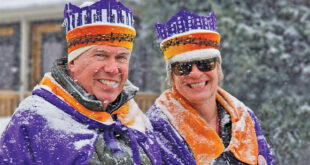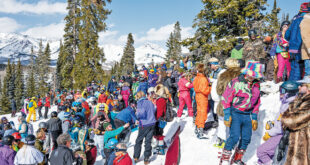On a recent Monday morning, scientists, graduate students and undergrads set out from Rocky Mountain Biological Laboratory (RMBL) in Gothic with butterfly nets, buckets and all manner of scientific tools to conduct research in the mountains. The town site of Gothic has been home to RMBL since 1928, playing host to what its website calls “one of the largest annual migrations of field biologists.”
But on this particular Monday, RMBL also played host to doctors, lawyers, historians, and teachers interested in the research conducted there. The group was part of the 3rd annual Geek Week, a seminar designed to introduce adults to the research taking place at RMBL and acquaint them with “the biology of a changing world.”
According to Dr. Amy Ellwein, Ph.D. and director of science education and communications, it’s a chance for the public to see behind the scenes at RMBL and learn that scientific research is about more than academic papers. It’s also about community.
“Because we’re not affiliated with a university, our scientists find us. They come from all over the country and we have a diverse group. We have people who don’t see each other all the time, just in summer, and have different ways of approaching science,” Dr. Ellwein said.
That means the collaboration is intense—the research benefits and so does the general feel of the place. There’s an energy and enthusiasm about the science, and Dr. Ellwein hopes that geek week will show the public that they don’t have to be scientists (or even geeks) to enjoy getting a first hand look at ground breaking research.
On Monday, Geek Week participants met with Dr. John Harte, Ph.D. from the University of California, Berkeley. He has been studying the effects of increased temperatures on plant life and soil carbon levels for 23 years, the first climate study of its kind and now the longest running.
Dr. Harte walked the group through his study’s findings and took them to the study site. But he also had a very practical goal for his audience: to arm them with factual responses to climate deniers.
“You feel they’re wrong but you don’t know crisp, clear, fact-based rebuttals. That’s what I’d like to help you with today,” Dr. Harte said.
The climate ecosystem tango
As Dr. Harte sees it, the relationship between climate change and the ecosystem is like the tango. Many subtle interactions take place between dance partners, and the same can be said for the interactions between a warming climate and ecosystems. There are climatological processes that enhance and diminish climate change, and understanding the full impact of climate change means studying those processes in more detail.
To explain, Dr. Harte gave a quick refresher on the direct cause of climate change, the release of greenhouse gases into the atmosphere at higher levels than exist naturally. Most of that increase comes from burning fossil fuels like gas, oil and coal, which account for 80 percent of global energy consumption. But other factors play a role, too: slashing and burning in third world countries, the release of methane from sheep and cattle, the use of nitrate heavy fertilizers, and ozone from smoggy cities all contribute to greenhouse gasses.
Dr. Harte explained that greenhouse gasses warm the atmosphere similar to the way a sleeping bag warms a person by trapping body heat. When sunlight reaches earth, some of it is absorbed as heat and some of it is reflected toward space by ice and snow (the albedo effect).
Greenhouse gasses act like a sleeping bag by trapping the heat that is produced when sunlight is absorbed at the earth’s surface. Without them, that heat would be radiated to space. When human activity increases greenhouse gases, it increases this warming effect.
The science behind climate change has been understood since the late 1800s. In 1896, a Swedish scientist named Svante Arrhenius figured it out and published his findings. “All we’ve done since is corroborate his findings and make the models more detailed,” Dr. Harte said.
The real room for debate comes in studying the impact of feedback on climate change. For example, as the average global temperature rises, snow and ice will melt in places like the mountains, Greenland and Antarctica. Less sunlight will be reflected back to space, more will be absorbed as heat, and the average global temperature will rise further. In turn, more ice and snow will melt and the cycle will continue.
“It’s called a positive feedback,” Dr. Harte explained, “and not because it’s good for you but positive because it creates an amplifying feedback effect.”
There are many kinds of feedback, and they could raise the average global temperature anywhere from one degree Fahrenheit to as much as six or more (scientists predict that direct climate change will increase the average global temperature one degree Celsius by about 2060). It’s in this arena that Dr. Harte has focused his studies in Gothic.
Nature tracking science
With the help of graduate students and 20 years of funding from the National Science Foundation, Dr. Harte cordoned off ten plots in the research meadow at Gothic. Half of them are heated 24 hours a day and have been since 1990—the temperature increase is the equivalent to one twenty-watt bulb for every square yard—and half are not.
Dr. Harte wanted to understand why historical fluctuations in the average global temperature have been accompanied by highly correlated fluctuations in carbon dioxide levels in the atmosphere. It appeared that the process of warming somehow added this greenhouse gas to the atmosphere, but no one knew where it came from.
His findings were surprising, and not just because he observed accelerated change in the heated plots, where snow melts two to three weeks earlier, and the soil is about two degrees warmer Celsius and 20 percent drier. The unheated plots are exhibiting similar changes but at a slower rate.
“Nature is tracking science,” he said. The findings of the study are already appearing in nature, to the point that he doesn’t call the unheated plots controls—he calls them ambient plots instead.
In all plots, forbs (the abundant wildflowers in the meadows around Gothic) are decreasing and shrubs (woody plants like sage) have increased. That does more than disappoint visitors to the Wildflower Capital of Colorado; it changes the way carbon is broken down and returned to the soil. In the heated plots, where forb production is greatly reduced and there is more sage, there has been a 25 percent reduction in soil carbon.
“Worldwide, there’s five times more carbon in the soil than elsewhere, so losing 25 percent in the soil could more than double the carbon dioxide in the air,” Dr. Harte said.
In some plant communities, the reduction in carbon isn’t permanent—over time, for example, sagebrush soils will recover carbon because of the quality of the dead plant matter that sage brush deposits into the soil. It decays slower than the dead plant matter that the wildflowers contribute to the soil and so it can accumulate to a higher level. Over the next several decades, meadow soils will lose carbon to the atmosphere but in the long run, soil carbon will accumulate.
From these results, Dr. Harte projects that in Western forests, where pollen records provide hints about possible changes in tree species composition under continued global warming, the forest soils will lose carbon to the atmosphere in both the short term and the long run. Dr. Harte’s research has helped the scientific community better understand one more type of feedback in the climate change dance.
Geek Week
At Geek Week, Dr. Harte’s new students peppered him with questions: how will he fund the study now that National Science Foundation funding has run out; how does he supply electricity to the heaters hanging over the plots; and who will take over his work as he approaches retirement.
“My department chair asked me about my retirement plan, and I said it was a gurney,” Dr. Harte joked about his determination to see the study move forward (a PhD student does seem poised to continue his work).
And in that moment, the significance of Geek Week was clear. Science wasn’t something in an academic journal or being reported on the news. It wasn’t even a football for political pundits. It was real—on the ground in front of the group’s feet—and that’s exactly the point according to Dr. Ellwein.
“It’s an amazing way to learn about science. There’s no intermediary lens of media or politics. It’s unique experience for many people and it’s accessible. And we’re all nice people,” she said with a laugh. “We don’t all wear white lab coats and have crazy white hair and write on chalk boards and hold test tubes.”
 The Crested Butte News Serving the Gunnison Valley since 1999
The Crested Butte News Serving the Gunnison Valley since 1999



